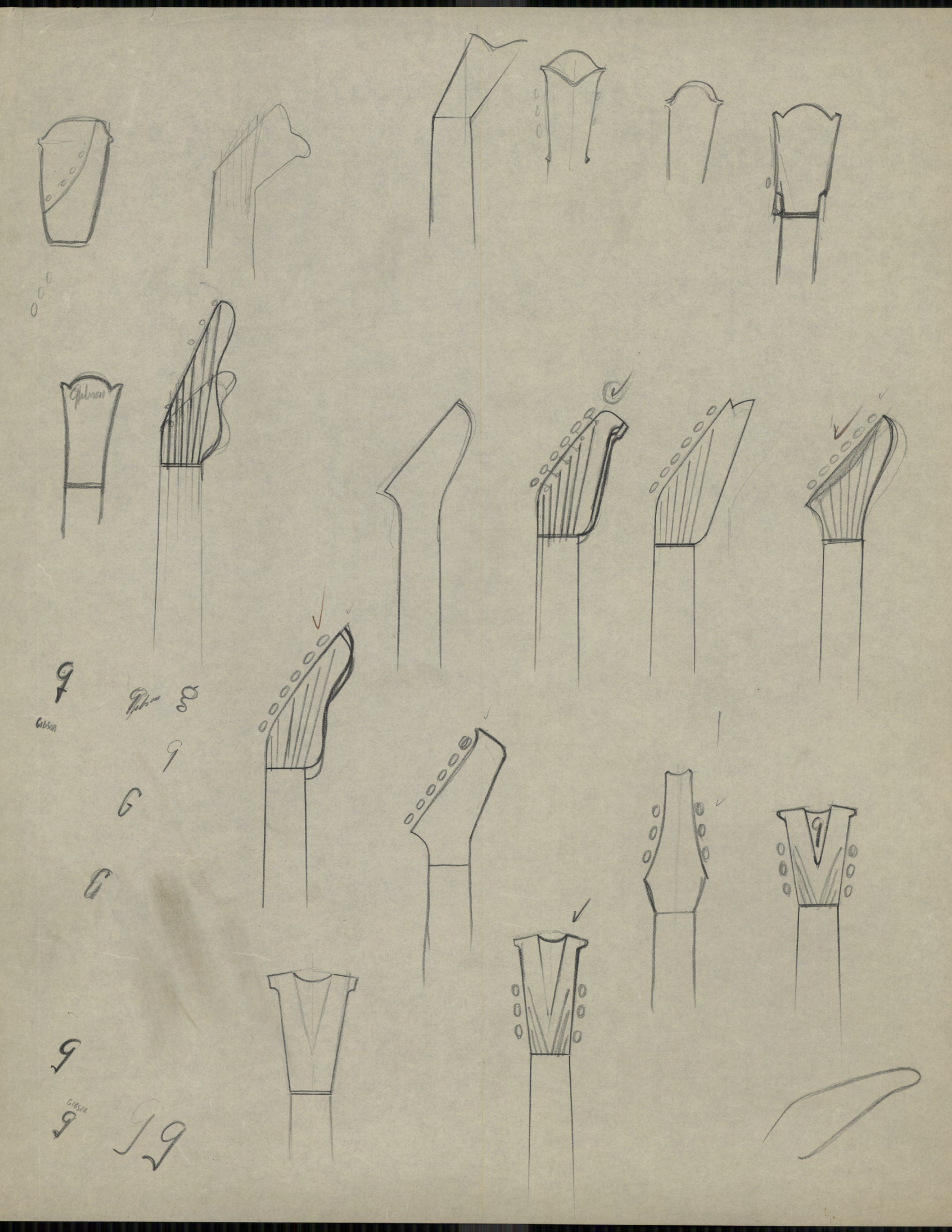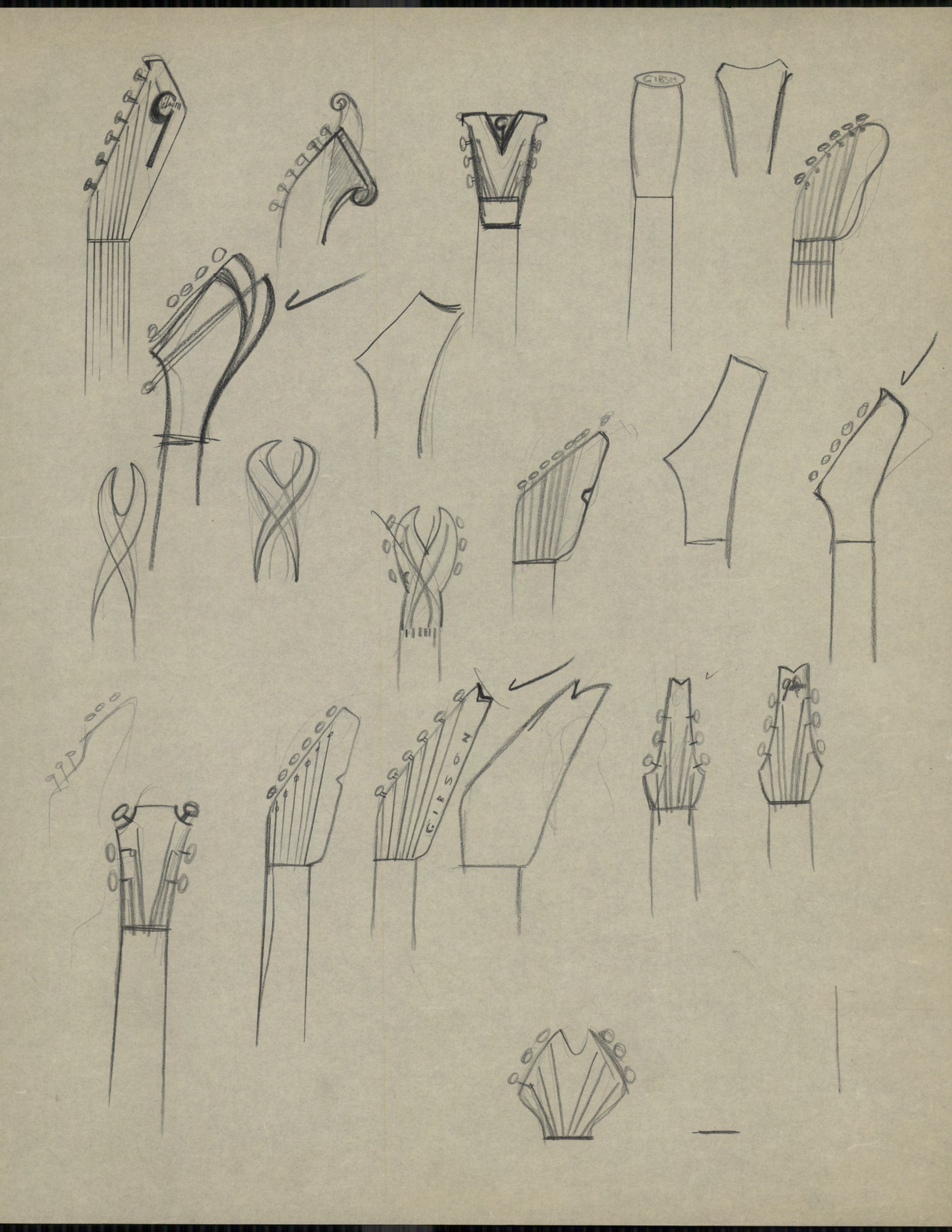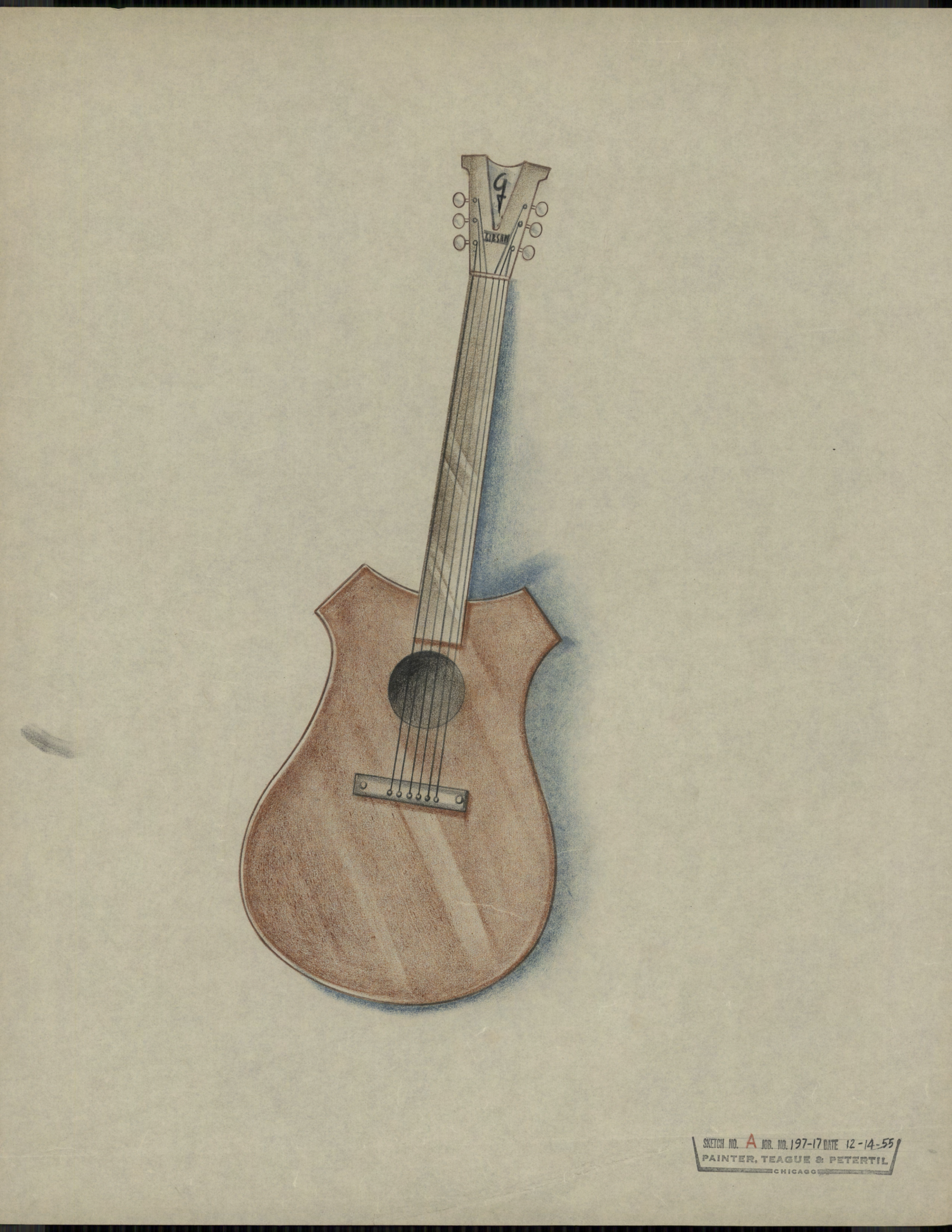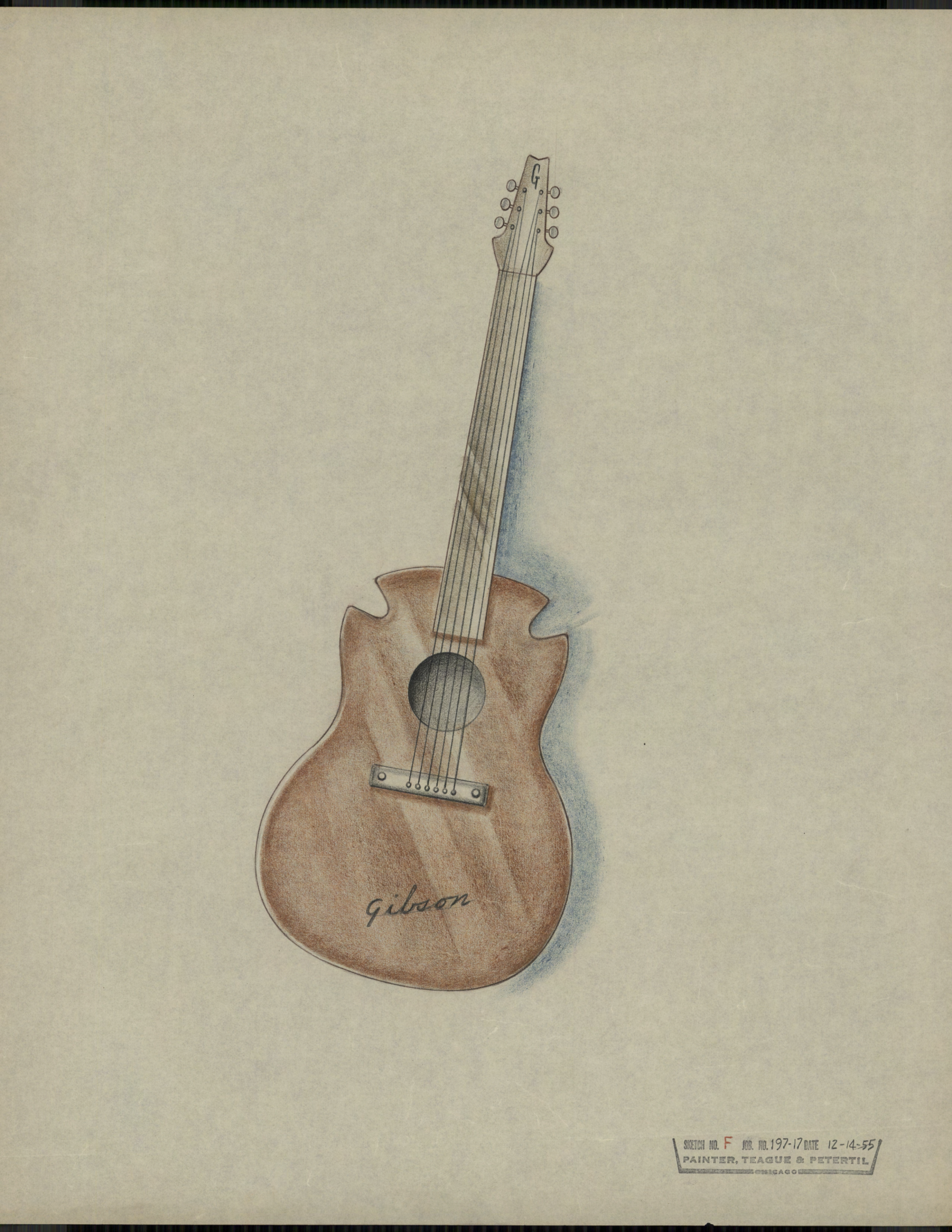Gibson HQ in 1955, and look—there’s the boss, Ted McCarty, sitting at a table with some guys from Painter Teague & Petertil (PTP), a Chicago design firm. They’re roughing out ideas for headstocks today, passing around pencils and paper as they draw and talk and share ideas. But just hold on a second. Some of the sketches look like early doodles for an Explorer-like pointy head—but this is three years early. The Explorer didn’t appear until 1958. So what’s going on?
It’s hardly a surprise that this kind of meeting took place. For any guitar maker, fresh ideas are essential. Fashion always changes; guitarists have a habit of seeking improvements; sales people regularly demand new product. But if like me you’re interested in Gibson history, you’ll want to know what was happening all those decades ago in Kalamazoo.
Mat Koehler is VP of Product at Gibson today, and around six years ago he was thumbing through his copy of Walter Carter’s 1994 book Gibson Guitars: 100 Years Of An American Icon. Some readers of that fine 300-page book may have missed a tiny illustration of PTP’s formal design drawings, the ones that followed those original sketches. Mat did first time around, too. But now he knew he had to act.


"Rediscovering the drawings in Walter’s book," Mat tells me, "prompted a search through Gibson’s archives to see if they were still there." Joining him on this hunt was Jason Davidson (Director, Product Development & Gibson Archives Curator), who spotted an interesting portfolio and called Mat over to take a look. And there they were! The sketches and PTP’s formal drawings. "That was the first time we understood when the drawings were made," he says, recalling the excitement of the find. "They’re dated November 14th 1955, and that just blew us away."
Thanks to Mat and Jason’s judicious archive diving, we can look in detail at those documents. They provide clues for a probable sequence that led from doodles to proposed designs, from rejected plans to classic models that include the Explorer and the ES-335.
I’ve already written about the Ultratone lap-steel material that Mat found after the searches at Gibson prompted him to visit the David Painter Papers collection at the Art Institute of Chicago. Painter worked at a design company called Barnes & Reinecke and then at his own firm, PTP. Both these companies provided designs for Gibson.

PTP’s formal designs from ’55 that turned up in the portfolio consist of six pen-and-ink drawings with color wash, each of a single flat-top acoustic. "Those whacky designs," Mat says, "I think came all around the same time, for a few years, where Gibson was trying to get to what became the Modernistic guitars, the Explorer and Flying V. But I think there were actually two paths. One was the wild pointy-shape things. The other path was what I believe led to the 335."
The initial sketches provide a rare view into an ideas session at Gibson, and the formal PTP designs that followed are indeed whacky—and remarkably fanciful. "I’m imagining a company, PTP, that really had no knowledge of guitars whatsoever," Mat continues, with a smile. "Up to this point, they’d designed rectangular plastic lap-steels for Gibson."
Nonetheless, the details of those six designs are intriguing. Perhaps a hint of Larson Bros in one of the body shapes, and from our vantage point today a few other outlines might ring a bell. One of the bodies in the drawings has a very unusual rectangular soundhole. And four of the headstocks have the pointy, droopy look, first proposed in the earlier sketches, and which we really ought to refer to as proto-Explorer types.
Mat agrees. "Yes, there’s definitely Explorer-style headstocks. These designs from ’55 are a conglomeration of different ideas, and I have to believe that Ted was working on the ES-335 and what became the Explorer and the Flying V simultaneously, because they were eventually announced at the same time, in 1958."
Arguably, the ES-335 was Gibson’s most revolutionary guitar. It combined some of the new electric developments in the air at the company during the ’50s—not least the thinline body (introduced for the Byrdland and 350T in ’55) and humbucking pickups (since ’57)—plus the fluctuating but apparent success of the Les Pauls. In ’52, the arrival of the solidbody Les Paul Model had followed Fender’s lead. A Gibson design, for sure, but devised in reaction to initiatives on the West Coast.
Gibson was aware that sales of its solidbody models were slipping and that some players still thought a solid electric just wasn’t for them. Perhaps a guitar with the sonic benefits of a solidbody in a hollowbody-like package could attract these doubters? Now, here was a true first for Gibson: a double-cutaway semi-solid electric guitar.



Early sales spiels for the 335 hinted at "semi-solid thin styling" and claimed that the "new body construction, with solid fitting neck, pickups, and adjustable bridge, provides the solidity essential for clear, sparkling, sustaining tone—while retaining a body size and shape that is easy and comfortable to hold." None of that revealed the precise truth, however, that the 335 had a solid block of wood running through the inside of its hollow body.
And the 335 body’s double cutaways—perhaps they had their origin in those PTP acoustic designs? "Certainly there’s a few double-cut acoustic shapes among them," Mat says, "and they all seem to be thinline. I do wonder if they could have fed into the development of the 335. Maybe that’s what they were getting at? And, arguably, the 335 was more of a Les Paul than a Les Paul, because it used the solidbody center of Les’s experimental Log guitar. So when I consider all these things together—another sketch that recently became the Theodore, the PTP acoustic concepts, and what became the Explorer and the Flying V and the 335—to me there’s a line that joins them all."
In hindsight, we can speculate about the significance of those drawings. But it’s not difficult to imagine the reaction back in 1955 when the six PTP designs first turned up at Gibson. Mat says that Ted McCarty would have shown them around to his team—Larry Allers, John Huis, Walt Fuller, and the rest. "And it’s entirely possible that they looked at this stuff and… well, they probably just laughed! They may have just thought these are hysterical, that they’re absolutely ridiculous!"
And then? As the rediscovery of the items decades later proves, somebody at the time must have felt they had some value, enough to file them away. "I don’t know how seriously they really considered these designs," Mat says. "But yes, they did save them. And I feel like they wouldn’t have saved them if they didn’t mean something in the progression of Gibson instruments."


He admits to some bias here. "The 335 is my favorite style of guitar," he adds, laughing. And there’s no doubting its historical importance, too. "Yes—it was the perfect fusion of two vastly different things: hollowbody and solidbody. And Gibson did it so elegantly, too."
It’s a pity we don’t have the facility of a time machine to go back to Kalamazoo in the ‘50s and determine exactly what prompted the Gibson designs that so many of us still cherish. But discoveries like these in the company’s archive at least provide some strong evidence.
"To me," Mat concludes, "the bigger-picture historical stuff is like putting the puzzle pieces together. What were they thinking when they did this stuff? And also, as radical as PTP’s whacky acoustic designs were, they surely did have some effect on what came later, not least the Explorer headstock style. To some people, they might just look like throwaway designs. But it’s clear to me they definitely influenced what was about to happen."
